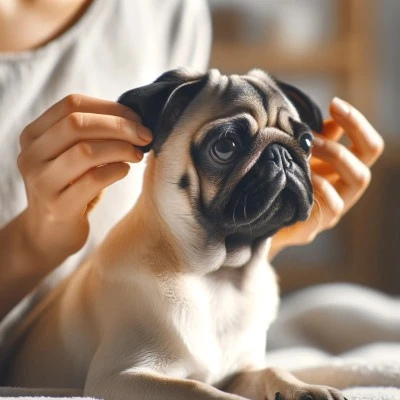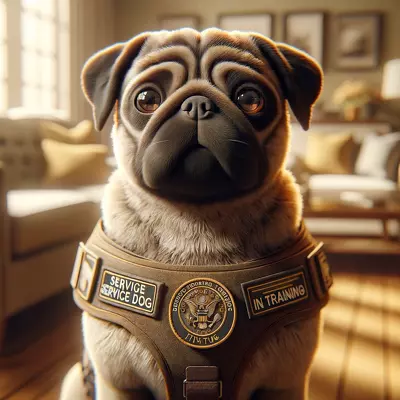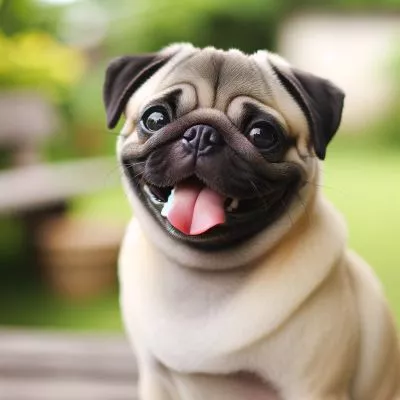Nurturing Your Pug’s Ears: A Detailed Blueprint for Cleaning and Preventing Infections

Pug owners often face unique challenges when it comes to their pet’s ear care. These adorable dogs, known for their distinctive facial features and playful personalities, also have a specific set of needs regarding ear hygiene. Proper ear cleaning is essential for preventing infections and ensuring the overall health of your pug. This article offers guidance on the best practices for maintaining the cleanliness and health of your pug’s ears, ensuring they remain happy and healthy.
I. Introduction to Ear Care in Pugs
Pugs, with their unique and lovable characteristics, are a joy to many pet owners. However, these charming canines require special attention, particularly when it comes to ear care. Their distinctive ear structure makes them prone to certain issues that, if neglected, can lead to discomfort or health problems. Understanding the importance of regular ear maintenance and being aware of common ear issues are crucial steps in ensuring the well-being of your pug.
A. Importance of Ear Hygiene in Pugs
Maintaining good ear hygiene is vital for pugs. Their floppy ears create a moist, warm environment ideal for the growth of bacteria and yeast. Regular cleaning helps prevent the buildup of wax and debris, which can lead to infections. Proper ear care not only keeps your pug comfortable but also prevents more serious complications that could arise from neglected ear health.
B. Common Ear Issues in Pugs
Pugs are susceptible to a variety of ear issues, including infections, mites, and wax buildup. Signs of these problems can include scratching, head shaking, redness, and an unpleasant odor. Recognizing these symptoms early and understanding how to address them is key to keeping your pug’s ears healthy.
II. Preparing to Clean Your Pug’s Ears
Before diving into the cleaning process, it’s important to know when and how to clean your pug’s ears safely and effectively.
A. Identifying When to Clean
Not every pug needs its ears cleaned with the same frequency. It’s essential to regularly check their ears for signs of wax buildup, debris, or any unusual odor. These indicators will tell you when it’s time for a cleaning session.
B. Gathering Necessary Supplies
To clean your pug’s ears, you will need a few basic supplies: a quality canine ear-cleaning solution, cotton balls or gauze, and treats to reward your pet. Avoid using cotton swabs as they can damage the ear canal.
C. Creating a Calm Environment
Ensure your pug is relaxed and comfortable before starting. Choose a quiet, familiar space and gently pet and soothe your dog to help them stay calm during the cleaning process.
III. Step-by-Step Guide on How to Clean Pugs Ears
Proper technique is vital for a safe and effective ear-cleaning process.
A. Examining the Ear
First, visually inspect the ear for any signs of redness, discharge, or foul odor. If these symptoms are present, it’s best to consult a veterinarian before proceeding.
B. Cleaning the Outer Ear
Gently fold back the ear flap and use a cotton ball dampened with an ear-cleaning solution to wipe away any visible dirt or wax. Be gentle, and do not force the cotton ball into the ear canal.
C. Addressing the Ear Canal
Apply a few drops of the ear-cleaning solution to the ear canal. Gently massage the base of the ear for a few seconds to help the solution break up any debris. Allow your pug to shake its head, then gently wipe away any dislodged material from the ear flap and the entrance of the ear canal.
D. Finishing Touches and Aftercare
Once the cleaning is done, offer your pug a treat as a reward. This helps create a positive association with ear cleaning. Keep an eye on your pug after cleaning to ensure there is no excessive scratching or discomfort.
IV. Tips for Preventing Ear Problems in Pugs
Regular care and monitoring are the best ways to prevent ear problems.
A. Regular Maintenance and Cleaning
Incorporate ear cleaning into your routine care schedule. Depending on your pug’s needs, this may be weekly or monthly.
B. Recognizing Signs of Ear Infections
Be vigilant for symptoms of ear infections, such as redness, swelling, discharge, or a strong odor. Early detection and treatment are crucial.
C. Diet and Nutrition for Healthy Ears
A balanced diet can support your pug’s overall health, including ear health. Some pugs may benefit from a diet formulated for skin and coat health, which can indirectly benefit ear health.
By following these guidelines and paying close attention to your pug’s ear health, you can ensure your furry friend remains happy, comfortable, and healthy.
V. FAQs
Q: How often should I clean my pug’s ears?
A: It varies depending on the individual dog, but generally, once every two weeks is recommended. Always check regularly for signs of wax build-up or irritation.
Q: Can I use human ear-cleaning solutions for my pug?
A: No, it’s best to use a cleaning solution specifically designed for dogs, as human products can be harmful to your pet.
Q: What should I do if my pug resists ear cleaning?
A: Try to make the process as gentle and stress-free as possible. Use treats and positive reinforcement. If resistance continues, consult a professional groomer or vet.
Q: Is it normal for pugs to have a lot of ear wax?
A: Some wax is normal, but excessive amounts can indicate a problem. If you’re concerned about the amount of wax, it’s best to consult with a vet.
Q: How can I tell if my pug has an ear infection?
A: Symptoms include redness, swelling, discharge, a bad smell, and your dog frequently scratching or shaking its head. If you notice these signs, visit a vet immediately.
Q: Should I pluck the hair from my pug’s ears?
A: It’s only usually necessary if your vet advises it due to excessive hair causing problems.
Q: Can ear problems in pugs lead to more serious health issues?
A: Yes, untreated ear problems can lead to more severe infections or even hearing loss. Regular cleaning and check-ups are essential.
Q: Why is my pug peeing in the house?
A: This could be due to a variety of reasons, such as a urinary tract infection, behavioral issues, or inadequate house training. Consulting with a vet can help identify the cause.
Q: How can I stop my puppy from biting my feet?
A: This is often a sign of playful behavior or teething. Redirect their attention to chew toys and use positive reinforcement training to discourage biting.
VI. Conclusion
A. Recap of Key Points
This article has provided comprehensive guidance on how to clean your pug’s ears, from preparation to the cleaning process itself. Emphasis has been placed on recognizing signs of ear issues and the importance of regular maintenance.
B. The Importance of Consistency in Ear Care
Consistent ear care is crucial for preventing infections and maintaining your pug’s overall health. Regular check-ups and cleaning routines can significantly reduce the risk of ear problems.
C. Encouraging Healthy Ear Habits
Incorporating ear care into your pug’s regular grooming routine and understanding the signs of potential issues will ensure your pet remains happy and healthy. Always approach ear care with patience and gentleness to make the experience positive for your pug.
VII. Suggested Readings
Pug care and training are essential topics for any pug owner. The following books provide valuable insights and practical advice:
- “The Everything Pug Book: A Complete Guide To Raising, Training, And Caring For Your Pug” by Kim Campbell Thornton: This book covers all aspects of pug care, from training to health issues.
- “The Complete Guide to Pugs: Finding, Training, Teaching, Grooming, Feeding, and Loving your new Pug Puppy” by David Anderson: Offers practical tips and insights for both new and seasoned pug owners.
- “Pugs – The Owner’s Guide from Puppy to Old Age” by Alex Seymour: A comprehensive guide covering all stages of a pug’s life.
- “The Pug: A Complete and Comprehensive Owners Guide” by Dog Care Professionals: Essential for understanding and caring for your pug.
- “PetPugDog’s GIANT Book of Pug Care”: A detailed book covering all aspects of pug care, emphasizing health and grooming.
These resources are invaluable for both new and experienced pug owners, offering a wealth of information on the unique needs and care requirements of this delightful breed. Whether you’re looking for training tips, dietary advice, or health care information, these books are an excellent starting point for ensuring your pug leads a happy, healthy life.






